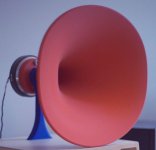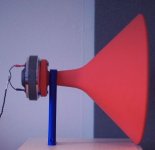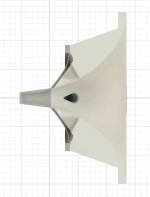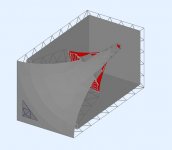Appendix B (page 58) shows how to convert this picture into a source definition for Ath: http://www.at-horns.eu/release/Ath-4.7.0-UserGuide.pdfMeasures...
//
Then it's only a small step from simulating a waveguide 😉
Thank you Mabat and Dr.Geddes for your amazing work and contribution to the community.
Here is some horns that I've generated using ATH and using with BMS4550 all the way down to 600hz.
I'm using an elliptical throat angle defined in this style
"Throat.Angle = 14 - 10*sin(p)^2"
which helps maintain loading and doesn't make the horn beam too much in the horizontal.
I unfortunately don't have access to my computer atm. and can't provide the simulation and measurements.


I print them standing and my printer really likes the oval shape, apart from the few cases when the throat didn't stick well enough and it got knocked out 50hours in...
The biggest challenge overall with 3D printing is finding filament that has a constant thickness as thickness variance causes the banding you were talking about Mabat.
Here is some horns that I've generated using ATH and using with BMS4550 all the way down to 600hz.
I'm using an elliptical throat angle defined in this style
"Throat.Angle = 14 - 10*sin(p)^2"
which helps maintain loading and doesn't make the horn beam too much in the horizontal.
I unfortunately don't have access to my computer atm. and can't provide the simulation and measurements.


I print them standing and my printer really likes the oval shape, apart from the few cases when the throat didn't stick well enough and it got knocked out 50hours in...
The biggest challenge overall with 3D printing is finding filament that has a constant thickness as thickness variance causes the banding you were talking about Mabat.
That's still my plan: Acoustic Horn Design – The Easy Way (Ath4)
Fortunately, the transparent epoxy doesn't get hot (not even warm - at least the one I have at hand) but cures very very slowly, typically (which also helps the bubbles to get out).
Very cool. Looking forward to that. I hope your epoxy doesn't have that yellow glow. Personally, that ruins it for me.
Formx.eu has a great selection of casting, molding and resin materials. It might be of use to you.
Can you expand on this a little?
The idea is lifted from Bill Waslo’s (bwaslo) implementation used on his SmallSyns design and more recently on his 3D printed unity horn. The latter of which originally had the woofer ports at the mouth of the waveguide, then further development had him concluding the ports were better off spaced outside the waveguide itself.
Here’s Bill’s explanation of the concept from another thread:
It's not so much the woofers being slotted, it's the woofers being spaced apart, basically the array effect (that normally gives comb-notching). They're spaced so that they start to cancel when you get way off-axis, the far one approaches being a half-wavelength further from you than the closer one. The dip is narrow in frequency range, though, while the drop in directivity from the midrange (in the waveguide) is less narrow, so the crossover has to be finessed to balance between mid and woofer to keep the directivity as even as possible with the woofer spacing effect working as low as it can. At least that's the intention. Below that it just goes omnidirectional, as usual. You can move the woofers further apart to make the effect happen as low in frequency as you want, but then the midrange has to provide directivity to a lower frequency (i.e., needs a bigger waveguide) to control it until the woofer spacing can help. So, it's only good for extending the waveguide directivity by a little bit (though the simulation imply something near an octave extension..... we'll see).
The point of the woofers feeding through slots (rather than just baffle mounting them below the waveguide) is for the vertical polar behavior. In the vertical, the waveguide directivity is gone already at a relatively high frequency, but if the woofer is too far away from the waveguide center vertically, it will start to cancel with the midrange and cause nulls. Sitting the woofers partially behind the waveguide and feeding their output through narrow slots at the edge of the waveguide keeps the effective centers of the woofers closer to the waveguide center, enough to still let the system perform like a point source. It's not a lot different from what happens with bass drivers in a Danley Synergy horn, where the woofers feed through slots in the waveguide near the mouth of the horn The horn doesn't really help the woofers' output any, but having them located there keeps them closer to the center of the other drivers so that the whole arrangement can still act like a point source; it's a good trick, and I think its aural benefits make it very worthwhile.
My arrangement differs in that I use a rectangular waveguide and put the woofer ports on the baffle instead of in the waveguide. And only put them on one side. in this version at least. Danley always seems to keep things balanced, for maximum SPL capability, I assume. This design is more focused on trying to get the best polar performance with a small size, and in something that doesn't require scary skills with a table or radial-arm saw.
aragorus - That's an interesting shape. Was it generated in one go or is it a compound? Did you employ a throat extension (Throat.Ext)? I'm not sure how would I get a similar shape 🙂
I'm looking forward to learn more about it. Very nice finish, BTW.
From the photos I would be a little worried about its acoustical performance. Wonder what the simulation showed.
I'm looking forward to learn more about it. Very nice finish, BTW.
From the photos I would be a little worried about its acoustical performance. Wonder what the simulation showed.
Last edited:
Yeah, I know what you mean. It shoud be perfectly clear and UV stable - is claimed.I hope your epoxy doesn't have that yellow glow. Personally, that ruins it for me.
Thanks Mabat
It was generated in one go by one of the older versions of ATH, and there is a horn extension of about 20mm I beilieve (which has the elliptical profile).
I have a feeling that the Throat.Ext doesn't work in the newest version.
Or maybe it just works with certain profiles.
I used matt PLA and that has coat of clear lack to seal and protect it.
I always use matt or wood filaments (the wood ones are easy to sand and stain afterwards.
Another slightly modified version of the same contour features 4 midrange taps.

The dark grey is my simplified model of the coaxial driver mounted on it.
The whole thing sits in a ported enclosure.

PS: Regarding the acoustic performance - it's pretty smooth, but beams a bit, as one will expect from such narrow throat extension.
I'll post simulations and measurements when I get to my stationary PC.
It was generated in one go by one of the older versions of ATH, and there is a horn extension of about 20mm I beilieve (which has the elliptical profile).
I have a feeling that the Throat.Ext doesn't work in the newest version.
Or maybe it just works with certain profiles.
I used matt PLA and that has coat of clear lack to seal and protect it.
I always use matt or wood filaments (the wood ones are easy to sand and stain afterwards.
Another slightly modified version of the same contour features 4 midrange taps.

The dark grey is my simplified model of the coaxial driver mounted on it.
The whole thing sits in a ported enclosure.

PS: Regarding the acoustic performance - it's pretty smooth, but beams a bit, as one will expect from such narrow throat extension.
I'll post simulations and measurements when I get to my stationary PC.
Last edited:
The idea is lifted from Bill Waslo’s (bwaslo) implementation used on his SmallSyns design and more recently on his 3D printed unity horn.
Thanks, now I understand. It read to me like you wanted to put a (slot-loaded) woofer on either side of the waveguide (like in one of these terrible center channel speakers) and that just made no sense to me.
But with this I agree. I also made the case for two horizontal woofers below the waveguide when I argued for the merits of an asymmetrical waveguide a few pages back. As you say we get even lower pattern control in the horizontal and in the vertical they’re still more or less omni at crossover, so there’s no narrowing and subsequent widening before the waveguide takes control in the horizontal.
According to my simulations it’s best to keep the two woofers as close as possible to each other though, as (and Bill mentions this too) things get pretty nasty off axis fast above the desired point of narrowing. So a steep filter is desirable as well.
The slot loading part had me a little confused first, but Bill’s explanation is interesting as he argues for it explicitly on the grounds of minimising CTC spacing and not for dispersion. Not something people who argue for axisymmetric waveguides would probably be particularly concerned about, but it does appeal to me (for not very scientific reasons I must admit).
To put my thoughts (and I think you’re thinking along similar lines) into numbers, although these are rough approximations, I didn’t look into size of baskets etc: Let’s take a 650mm wide 90 x 45 waveguide (for the sake of simplicity, I’d prob prefer 55 or 60) on top of a 650mm wide baffle with two 12-inch woofers right next to each other. They start narrowing at 250 to 300 Hz and are -6dB at 45 degrees around 550Hz on the horizontal axis, but as mentioned there’s already a deep null at about 780Hz (at 45 degrees). In the vertical they’re still far from narrowing at crossover, so there’s no narrowing-widening-narrowing, but of course there won’t be any pattern control until maybe 2k or even higher, when the waveguide takes over vertically. You also get a cleaner forward lobe than with an axisymmetric waveguide.
To me this sounds like a pretty good compromise, but of course the big drawback is about two full octaves of no vertical pattern control compared to an axisymmetric waveguide of the same size. Pick your poison, and I’m not saying this is necessarily the best way at all, but I think it’s a reasonable route to take depending on your priorities.
Another slightly modified version of the same contour features 4 midrange taps.
View attachment 923585
The dark grey is my simplified model of the coaxial driver mounted on it.
The whole thing sits in a ported enclosure.
View attachment 923586
This is super interesting! Have you looked at Danley's studio monitors? It's hard to tell from the pictures available, but it seems to me he might be doing something similar even though these are small 6,5" drivers.
Trying to get Ath runing on my OS X comp after installing Wine as suggested above.. I get...
I run it like this in Linux. Should work in OS X too:
Code:
$ cd <path_to_ath4_directory>
$ wine ./ath.exe <path_to_horn_definition_file>I did some looking around and you're right that there are some problems with Catalina and later. Apple disabled support for 32-bit code by default in Catalina which means that upstream wine can only run 64-bit programs. Fortunately, Ath4 seems to be 64-bit so it should work from what I understand (I have not tested this).
Apparently CrossOver from CodeWeavers supports 32-bit applications on Catalina and Big Sur. It seems that you can install an unofficial CrossOver build for free with homebrew. (Note: This is legal. The CrossOver source code is freely available because it is based on Wine, which is LGPLv2.1 licensed, and other GPL/LGPL/X11 licensed projects.)
Apparently CrossOver from CodeWeavers supports 32-bit applications on Catalina and Big Sur. It seems that you can install an unofficial CrossOver build for free with homebrew. (Note: This is legal. The CrossOver source code is freely available because it is based on Wine, which is LGPLv2.1 licensed, and other GPL/LGPL/X11 licensed projects.)
Crossover should work.
I have recently installed software on some Macbooks with Apple Silicon.
One of these is coming back so I could check out Crossover 20.04.
I have recently installed software on some Macbooks with Apple Silicon.
One of these is coming back so I could check out Crossover 20.04.
Last edited:
....It was generated in one go by one of the older versions of ATH, and there is a horn extension of about 20mm I beilieve (which has the elliptical profile).
I have a feeling that the Throat.Ext doesn't work in the newest version.
Or maybe it just works with certain profiles.
PS: Regarding the acoustic performance - it's pretty smooth, but beams a bit, as one will expect from such narrow throat extension.
I'll post simulations and measurements when I get to my stationary PC.
Very interesting!
This is similar to what I have in mind.
It should be possible to parametrically define such a profile, even as an optimized "complete" 3D horn ("What does that mean?" 😉), but the math involved is killing.
How did you arrive at the throat length and the circumference of the ellipse?
Looking forward to your sims and measurements!
Last edited:
@aragorus, I was hoping / waiting for someone to make such a horn and you did, so kudos to you!
I run it like this in Linux. Should work in OS X too:
Code:$ cd <path_to_ath4_directory> $ wine ./ath.exe <path_to_horn_definition_file>
Thanks!
I'm running El Capitan 10.11
If I doble-click the Wine application in Finder I get a new terminal window with:
################################################################################
# Wine Is Not an Emulator #
################################################################################
Welcome to wine-5.0.
In order to start a program:
.exe: wine program.exe
.msi: wine msiexec /i program.msi
If you want to configure wine:
winecfg
To get information about app compatibility:
appdb Program Name
Jo-Mac-Pro:~ MacPro$ appdb
At enter of appdb, it send my default browser to a web page with programs.. so something works 🙂
But:
Jo-Mac-Pro:ath MacPro$ wine ath.exe /Applications/Ath/demos/demo1.cfg
0009:err:module:__wine_process_init failed to load L"Z:\\Volumes\\Home\\Users\\MacPro\\applications\\ath\\ath.exe", error c0000020
Jo-Mac-Pro:ath MacPro$
Maybe this is the problem you talk about?
//
@Ro808 - Thanks!
When I generated the horn I didn't think so much about the compression driver. Other than the throat diameter and exit angle.
Atm I'm trying to make a more inclusive model, containing the CD extension of the MEH horn as well as the ports and woofer membrane. But I'm no AKABAK guru.

In the future I'll try to model the inner works of the BMS4550, even though it looks like a tough challenge. For now I'm just trying to approximate the wave shape
When I generated the horn I didn't think so much about the compression driver. Other than the throat diameter and exit angle.
Atm I'm trying to make a more inclusive model, containing the CD extension of the MEH horn as well as the ports and woofer membrane. But I'm no AKABAK guru.

In the future I'll try to model the inner works of the BMS4550, even though it looks like a tough challenge. For now I'm just trying to approximate the wave shape

- Home
- Loudspeakers
- Multi-Way
- Acoustic Horn Design – The Easy Way (Ath4)